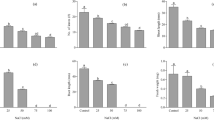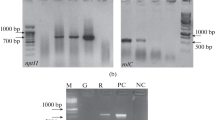Abstract
In a carrot (Daucus carota L.) cell line lacking the ability to undergo somatic embryogenasis, and in carrot and anise (Pimpinella anisum L.) cell lines in which embryogenesis could be regulated by presence or absence of 2,4-dichlorophen-oxyacetic acid (2,4-D), in the medium (+2,4-D=no embryogenesis,-2,4-D=embryo differentiation and development), the levels of endogenous gibberellin(s) (GA) were determined by the dwarfrice bioassay, and the metabolism of [3H]GA1 was followed. Embryos harvested after 14 d of subculture in-2,4-D had low levels (0.2–0.3 μg g-1 dry weight) of polar GA (e.g. GA1-like), but much (3–22 times) higher levels of less-polar GA (GA4/7-like); GA1, GA4 and GA7 are native to these cultures. Conversely, the undifferentiated cells in a non-embryogenic strain, and proembryos of an embryogenic strain (+2,4-D) showed very high levels of polar GA (2.9–4.4 μg g-1), and somewhat reduced levels of less-polar GA. Cultures of anise undergoing somatic embryo development (-2,4-D) metabolized [3H]GA1 very quickly, whereas proembryo cultures of anise (+2,4-D) metabolized [3H]GA1 slowly. The major metabolites of [3H]GA1 in anise were tentatively identified as GA8-glucoside (24%), GA8 (15%), GA1-glucoside (8%) and the Δ1(10)GA1-counterpart (2%). Thus, high levels of a GA1-like substance and a reduced ability to metabolize GA1 are correlated with the absence of embryo development, while lowered levels of GA1-like substance and a rapid metabolism of GA1 into GA8 and GA-conjugates are correlated with continued embryo development. Exogenous application of GA3 is known to reduce somatic embryogenesis in carrot cultures; GA4 was found to have the same effect in anise cultures. Thus, a role (albeit negative) in somatic embryogenesis for a polar, biologically active GA is implied.
Similar content being viewed by others
Abbreviations
- 2,4-D:
-
2,4-dichlorophenoxyacetic acid
- GA:
-
gibberellin(s) or gibberellin-like substances
- GC-RC:
-
gas chromatography-radiochromatogram counting
- HPLC:
-
high-presare liquid chromatography
- Rt:
-
retention time
- TLC:
-
thinlaver chromatography
References
Alpi, A., Tognoni, F., D'Amato, F. (1975) Growth regulator levels in embryo and suspensor of Phaseolus coccineus at two stages of development. Planta 127, 153–162
Alpi, A., Lorenzi, R., Cionni, P.G., Bennici, A., D'Amato, F.A. (1979) Identification of gibberellin A1 in the embryo suspensor of Phaseolus coccineus. Planta 147, 225–228
Bray, G.A. (1960) A simple efficient liquid scintillator for counting aqueous solutions in a liquid scintillation counter. Anal. Biochem. 1, 279–285
Cionini, P.G., Bennici, A., Alpi, A., D'Amato, I. (1976) Suspensor, gibberellin and in vitro development of Phaseolus coccineus embryos. Planta 131, 115–117
Durley, R.C., MacMillan, J., Pryce, R.J. (1971) Investigation of gibberellins and other growth substances in the seed of Phaseolus multiflorus and of Phaseolus vulgaris by gas chromatography and by gas chromatography-mass spectrometry. Phytochemistry 10, 1891–1908
Durley, R.C., Crozier, A., Pharis, R.P., McLaughlin, G.E. (1972) Chromatography of 33 gibberellins on a gradient cluted silicagel partition column. Phytochemistry 11, 3029–3033
Durley, R.C., Sassa, T., Pharis, R.P. (1979) Metabolism of tritiated gibberellin A20 in immature seeds of dwarf pea, cv. Meteor. Plant Physiol. 64, 214–219
Fujimura, T., Komamine, A. (1975) Effects of various growth regulators on the embryogenesis in a carrot cell suspension culture. Plant Sci. Lett. 5, 359–364
Gamborg, O.L., Miller, R.A., Ojima, K. (1968) Nutrient requirement of suspension cultures of soybean root cells. Exp. Cell Res. 50, 148–151
Glenn, J.L., Kuo, C.C., Durley, E.C., Pharis, R.P. (1972) Use of insoluble polyvinylpyrrolidone for purification of plant extracts and chromatography of plant hormones. Phytochemistry 11, 345–351
Goodwin, R.B. (1978) Phytohormones and fruit growth. In: Phytohormones and related compounds — a comprehensive treatise, vol. 2, pp. 175–214, Letham, D.S., Goodwin, P.B., Higgins, T.J.V., eds. Elsevier/North-Holland, Amsterdam
Halperin, W. (1970) Embryos from somatic plant cells. In: Control mechanisms in the expression of cellular phenotypes, Symp. Int. Soc. for Cell Biol., pp. 169–191, Padykula, H.A., ed. Academic Press, New York London
Huber, J., Constabel, F., Gamborg, O.L. (1978) A cell counting procedure applied to embryogenesis in cell suspension cultures of anise (Pimpinella anisum L.). Plant Sci. Lett. 12, 209–215
Murakami, Y. (1968) A new rice seedling test for gibberellins, ‘micro method’, and its use for testing extracts of rice and morning glory. Bot. Mag. 81, 33–43
Noma, M., Huber, J., Pharis, R.P. (1979) Occurrence of 376-1 A1 counterpart, GA1, GA4 and GA7 in somatic cell embryo cultures of carrot and anise. Agric. Biol. Chem. 43, 1793–1794
Sembdner, G., Borgmann, E., Schneider, G., Liebisch, H.W., Miersch, O., Adam, G. (1976) Biological activity of some conjugated gibberellins. Planta 132, 249–257
Sponsel, V.M. (1980) Gibberellin metabolism in legume seeds. British Plant Growth Regulation Group, Monogr. No. 5, pp. 49–62. ARC, Oxfordshire, U.K.
Sponsel, V.M., MacMillan, J. (1978) Metabolism of gibberellin A29 in seeds of Pisum sativum cv. Progress No. 9: use of [2H] and [3H] GAs, and the identification of a new GA catabolite. Planta 144, 69–78
Skene, K.G.M., Carr, D.J. (1961) A quantitative study of the gibberellin content of seeds of Phaseolus vulgaris at different stages of their development. Aust. J. Biol. Sci. 14, 13–25
Skene, K.G.M. (1970) The gibberellins of developing bean seeds. J. Exp. Bot. 21, 236–246
Tisserat, B., Burashige, T. (1977) Repression of asexual embryogenesis in vitro by some plant growth regulators. In Vitro 13, 799–805
Yamane, H., Murofushi, N., Takahashi, N. (1975) Metabolism of gibberellins in maturing and germinating bean seeds. Phytochemistry 14, 1195–1200
Yamane, H., Murofushi, N., Osada, H., Takahashi, N. (1977) Metabolism of gibberellins in early immature bean seeds. Phytochemistry 16, 831–835
Author information
Authors and Affiliations
Rights and permissions
About this article
Cite this article
Noma, M., Huber, J., Ernst, D. et al. Quantitation of gibberellins and the metabolism of [3H]gibberellin A1 during somatic embryogenesis in carrot and anise cell cultures. Planta 155, 369–376 (1982). https://doi.org/10.1007/BF00394464
Received:
Accepted:
Issue Date:
DOI: https://doi.org/10.1007/BF00394464




